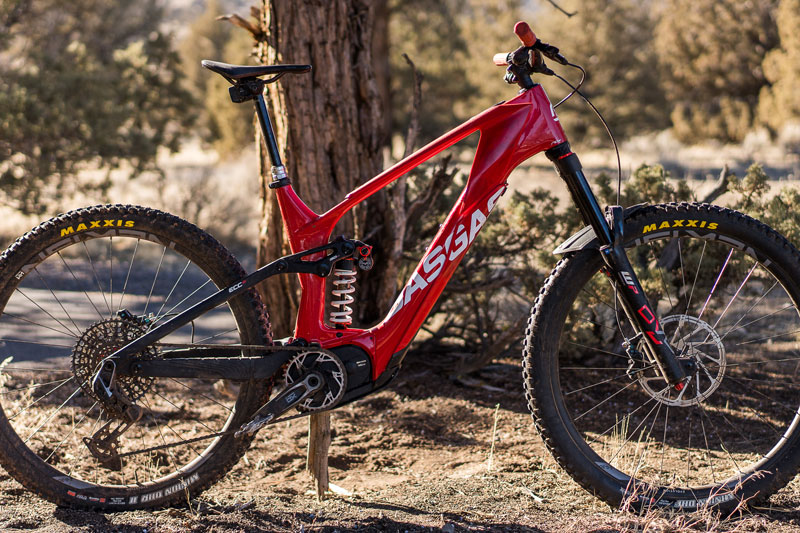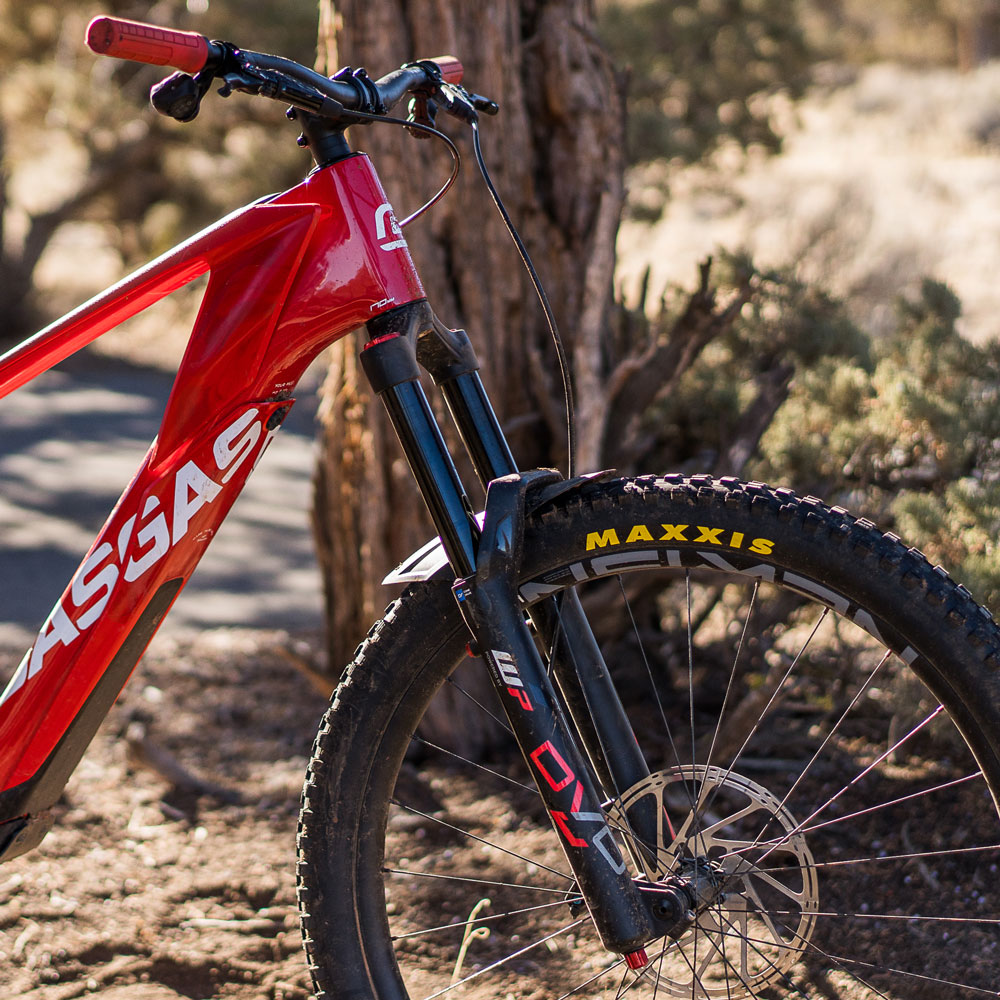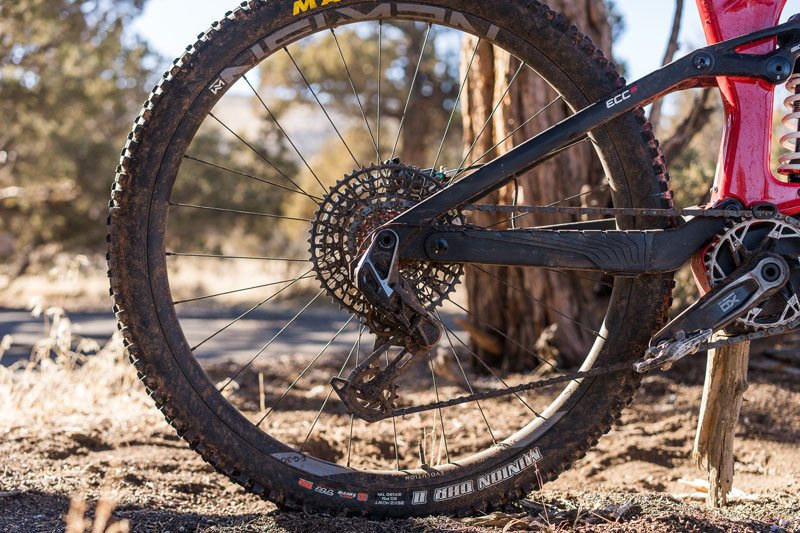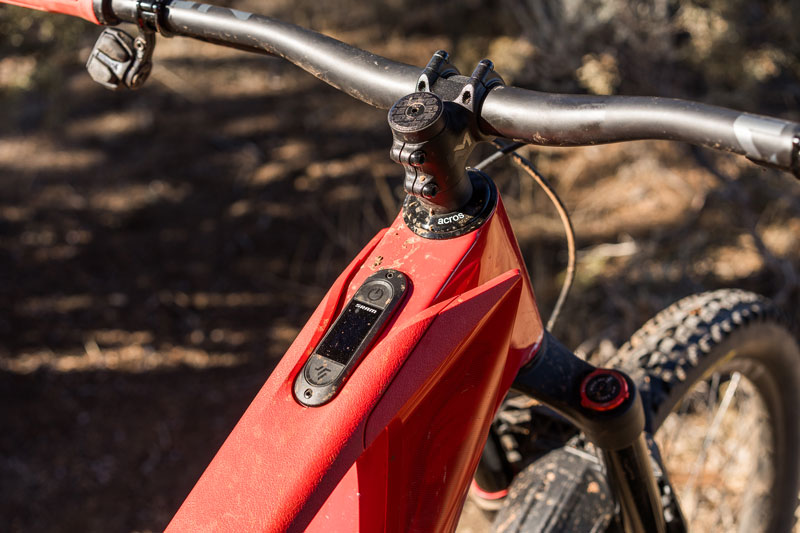As with all of our Dissected Features, this is not intended to be a long-term review or endorsement of a product but is instead a chance for our viewers and readers to get a deep dive look into some of the newest tech and products in the mountain bike space. We thank GasGas for the opportunity to create this feature and get you some valuable beta on the ECC 6 eMTB.
ABOUT THE GASGAS ECC 6
GasGas is offering the ECC in three models with various build specs. MSRP on the different models is suggested as follows: ECC 4 $6,999, ECC 5 at $8999 and our top-of-the-line ECC 6 at $10,999. Playing in the comfortable and familiar zone, GasGas employs a Horst Link suspension platform on the ECC 6’s 160mm of rear wheel travel. A 205x65mm coil shock sits out back with a 170mm fork handling the hits out front. The suspension has a few unique talking points, which we’ll get to soon. Let’s finish up the frame first.
The fully carbon fiber frame’s bright red paint certainly draws attention to this rig, no matter if it’s on the back of a car or on the trail. Pulling the removable plastics off further highlights the smooth lines and overall clean aesthetic of this bike. If you choose to keep the protective/decorative plastics on board, GasGas claims you will reap some benefits should the bike fall over and land on them instead of the carbon frame. The downside was that you could also experience some cable rattle.
SUSPENSION | At first you could be fooled into thinking that some standard DVO suspension is found on the bike, however upon closer inspection, you’ll notice that it’s a DVO and WP suspension collaboration. Bringing over some of WP’s motorsport championship winning suspension influence, the DVO/WP units feature Cone Valve Technology, which offers a notably different ride feel to discerning riders. We’ll touch on that below, but you can think of it like an adjustable blow-off valve on the high speed circuit, which gives a bit better platform and maintains efficiency but opens up effectively for larger hits.
The chassis for the collaborative tune is a DVO Onyx D1 fork, sporting 170mm of travel, which is paired with a DVO Jade X Coil shock.
The ECC’s nearly 20% progression rate provides a very neutral and predictable feeling through the travel. Keeping in tune with the unpolarizing feel of the rear suspension is a 115% anti-squat value at sag. Anti-rise has a mild curve from roughly 46.5% to 50%. This all means the bike performs like many other Horst Link bikes that people have enjoyed over the decades. No weird spikes, dives or harshness.
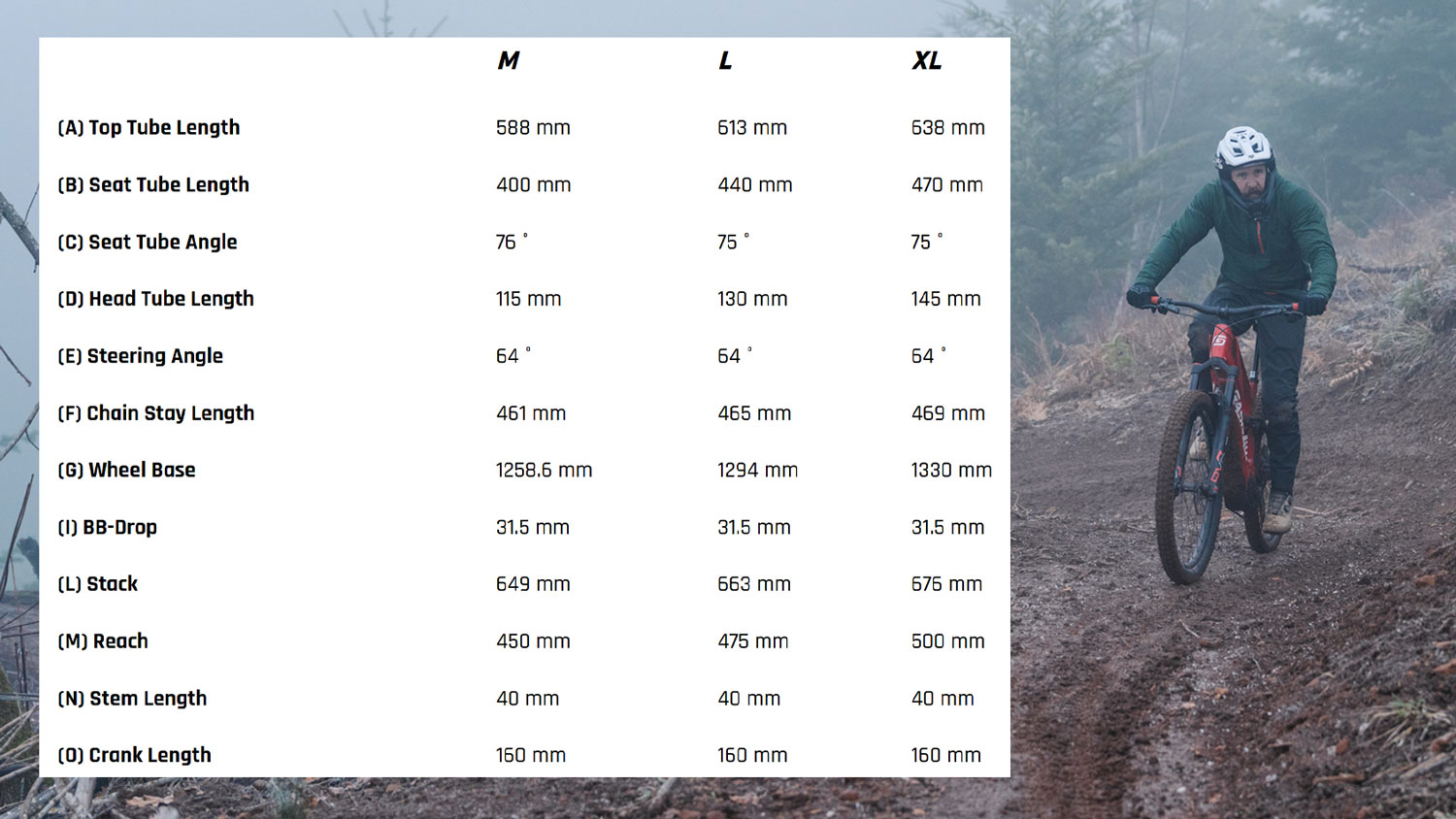
GEOMETRY | When it comes to the ECC’s geometry, number crunchers will likely find a few standout dimensions with a host of familiar numbers mixed in. At 5’11 to 6’, we chose the size medium, and will be testing that for our long-term review. GasGas offer three sizes for the ECC, and our medium has a 475mm reach. Chainstay lengths are all very long, but change based on the frame size. The chainstays run from 461mm, through 465mm, and up to 469mm. The long rear end is one of the more polarizing numbers, as it has significant pros and cons depending on the type of terrain and rider. The wheelbase on our medium sits at 1,289mm with the large spanning a whopping 1,325mm.
The other standout number is stack height. A very tall stack height ranges from 649mm on the small to 676mm on the large. Our size medium has a 663mm stack, which resulted in us running the stem as low as possible to maintain a full range of motion.
Overall, geometry gives a pretty strong and solid position over the bike, which inspired speed and confidence. Up front the ECC 6 has a 64-degree head tube angle, which helps keep the bike maneuverable while the long wheelbase and weight keep it planted and confident. Per GasGas’s geo chart they state the seat tube angle at 75 degrees. However, after personally measuring it as my seat height, it checked at 78.6 degrees. A solid 31.5mm bottom bracket drop combined with the stack and long rear end further enhance the “in the bike” feel that inspires true confidence at speed.

SRAM POWERTRAIN | The integration of the SRAM Eagle Powertrain in the GasGas frame is solid overall, and the wireless AXS controllers mean there’s not a lot to get in the way or clutter your cockpit. The drive unit features 90Nm of torque and offers 680W of peak power. The SRAM unit delivers power over a nice range of cadences; however, we found that it requires more rider input than some other systems, which may be exactly what you want out of your eBike experience.

THE WOLF’S FIRST IMPRESSIONS
As with all of our Dissected Features, this is not intended to be a long-term review or an endorsement. Instead, it is an opportunity to work with the brands to learn about the bike, development and share some of the unique features about it.
During our research and learning phase of this project, we were lucky enough to chat with GasGas’s pro athletes, who have been pushing these bikes to the limits. In addition, we spoke with their engineering and development team about the future of GasGas eMTB, and what it was like developing this awesome machine.
During the winter months that we’ve had this bike for filming and research, our riding has been limited to the desert trails in our region, which is honestly the best place for this thing. The high-speed, wide open singletrack with steep chutes and chunky rock gardens just get eaten up by this planted enduro eMTB. We also made a couple of field trips to some more woodsy regions to learn the bike’s capabilities for this initial shake down.
We spent a fair amount of time tinkering with the DVO/ WP suspension and believe we’ve laned on happy tune, albeit a unique one. It took us a bit of time to balance sensitivity with support in the mid-stroke and reaching full travel, but we were satisfied after about four rides that we found the right mix for our fork settings. However, our long-term review will flesh out just how it stacks up to more traditional systems.

The slightly heavier weight of 53.5lbs and longer rear end meant the bike rode a bit heavier than some, and was a bit more physically involved to get airborne on smaller features and lips. If the speed was high and the lips were mellow, the bike loved to get airborne, and landed smoothly no matter how deep we sent it. Like the smaller and steeper lips, tighter bits of trails and low speed drops into turns required a bit more precise timing to execute. The rear end stayed on top of obstacles a bit longer than we expected, occasionally throwing us off a little.
We realize not all riders spend time on these types of terrains, so we focused more time and energy riding this bike where it seems to shine. Big days pedaling to your favorite high-speed descents, exploring nature or trying to set PRs on long fast descents are great fun aboard the GasGas ECC 6. The geometry struck a nice balance in these scenarios and made for a fun yet stable bike that really built confidence and inspired us to keep our fingers off the brakes.
GasGas seem to be onto something with their ECC enduro line and we’re excited to see what comes next. Until then, we are going to keep stacking miles and smiles aboard the ECC 6 and passing it around to the crew for more testing. ![]()
SHARE THIS DISSECTED FEATURE

SUPPORT AND JOIN THE LOAM WOLF PACK
Did you find this feature helpful? Would you like the chance to review (and keep) products? Are you interested in saving big bucks by getting exclusive Members Only discounts from industry brands all while helping support a small, rider-owned media crew? We have big plans for our members beyond big discounts and product giveaways! To learn more and help support small, independent media, visit our Member’s Page.

